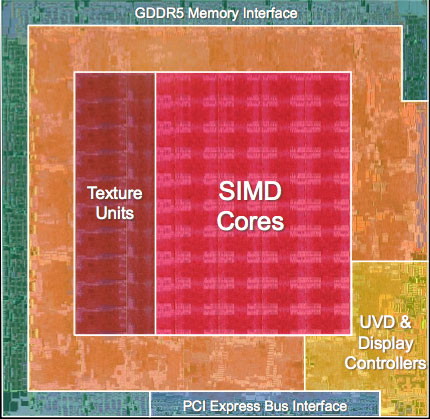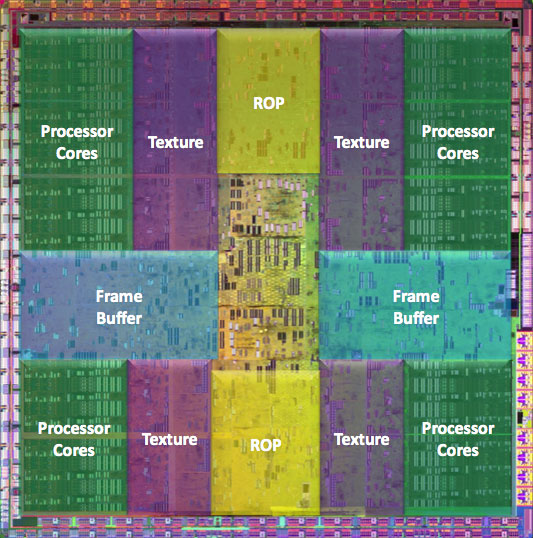The Radeon HD 4850 & 4870: AMD Wins at $199 and $299
by Anand Lal Shimpi & Derek Wilson on June 25, 2008 12:00 AM EST- Posted in
- GPUs
Wrapping Up the Architecture and Efficiency Discussion
Engineering is all about tradeoffs and balance. The choice to increase capability in one area may decrease capability in another. The addition of a feature may not be worth the cost of including it. In the worst case, as Intel found with NetBurst, an architecture may inherently flawed and a starting over down an entirely different path might be the best solution.
We are at a point where there are quite a number of similarities between NVIDIA and AMD hardware. They both require maintaining a huge number of threads in flight to hide memory and instruction latency. They both manage threads in large blocks of threads that share context. Caching, coalescing memory reads and writes, and handling resource allocation need to be carefully managed in order to keep the execution units fed. Both GT200 and RV770 execute branches via dynamic predication of direction a thread does not branch (meaning if a thread in a warp or wavefront branches differently from others, all threads in that group must execute both code paths). Both share instruction and constant caches across hardware that is SIMD in nature servicing multiple threads in one context in order to effect hardware that fits the SPMD (single program multiple data) programming model.
But the hearts of GT200 and RV770, the SPA (Steaming Processor Array) and the DPP (Data Parallel Processing) Array, respectively, are quite different. The explicitly scalar one operation per thread at a time approach that NVIDIA has taken is quite different from the 5 wide VLIW approach AMD has packed into their architecture. Both of them are SIMD in nature, but NVIDIA is more like S(operation)MD and AMD is S(VLIW)MD.

AMD's RV770, all built up and pretty
Filling the execution units of each to capacity is a challenge but looks to be more consistent on NVIDIA hardware, while in the cases where AMD hardware is used effectively (like Bioshock) we see that RV770 surpasses GTX 280 in not only performance but power efficiency as well. Area efficiency is completely owned by AMD, which means that their cost for performance delivered is lower than NVIDIA's (in terms of manufacturing -- R&D is a whole other story) since smaller ICs mean cheaper to produce parts.

NVIDIA's GT200, in all its daunting glory
While shader/kernel length isn't as important on GT200 (except that the ratio of FP and especially multiply-add operations to other code needs to be high to extract high levels of performance), longer programs are easier for AMD's compiler to extract ILP from. Both RV770 and GT200 must balance thread issue with resource usage, but RV770 can leverage higher performance in situations where ILP can be extracted from shader/kernel code which could also help in situations where the GT200 would not be able to hide latency well.
We believe based on information found on the CUDA forums and from some of our readers that G80's SPs have about a 22 stage pipeline and that GT200 is also likely deeply piped, and while AMD has told us that their pipeline is significantly shorter than this they wouldn't tell us how long it actually is. Regardless, a shorter pipeline and the ability to execute one wavefront over multiple scheduling cycles means massive amounts of TLP isn't needed just to cover instruction latency. Yes massive amounts of TLP are needed to cover memory latency, but shader programs with lots of internal compute can also help to do this on RV770.
All of this adds up to the fact that, despite the advent of DX10 and the fact that both of these architectures are very good at executing large numbers of independent threads very quickly, getting the most out of GT200 and RV770 requires vastly different approaches in some cases. Long shaders can benefit RV770 due to increased ILP that can be extracted, while the increased resource use of long shaders may mean less threads can be issued on GT200 causing lowered performance. Of course going the other direction would have the opposite effect. Caches and resource availability/management are different, meaning that tradeoffs and choices must be made in when and how data is fetched and used. Fixed function resources are different and optimization of the usage of things like texture filters and the impact of the different setup engines can have a large (and differing with architecture) impact on performance.
We still haven't gotten to the point where we can write simple shader code that just does what we want it to do and expect it to perform perfectly everywhere. Right now it seems like typical usage models favor GT200, while relative performance can vary wildly on RV770 depending on how well the code fits the hardware. G80 (and thus NVIDIA's architecture) did have a lead in the industry for months before R600 hit the scene, and it wasn't until RV670 that AMD had a real competitor in the market place. This could be part of the reason we are seeing fewer titles benefiting from the massive amount of compute available on AMD hardware. But with this launch, AMD has solidified their place in the market (as we will see the 4800 series offers a lot of value), and it will be very interesting to see what happens going forward.










215 Comments
View All Comments
natty1 - Thursday, June 26, 2008 - link
There's no good reason to pull that garbage. People assume they are seeing raw numbers when they read these reviews.DerekWilson - Sunday, June 29, 2008 - link
i don't understand what you mean by raw numbers ... these are the numbers we got in our tests ...we can't do crossfire on the nvidia board we tested and we can't do sli on the intel board we tested ...
we do have another option (skulltrail) but people seemed not to like that we went there ... and it was a pain in the ass to test with. plus fb-dimm performance leaves something to be desired.
in any case, without testing every solution in two different platforms we did the best we could in the time we had. it might be interesting to look at testing single card performance in two different platforms for all cards, but that will have to be a separate article and would be way to tough to do for a launch.
Denithor - Wednesday, June 25, 2008 - link
In Bioshock in the multiGPU section the SLI 9800GTX+ seems to fall down on the job. In all other benches this SLI beats out the GTX 280 easily, here it fails miserably. While even the SLI 8800GT beats the GTX 280. Methinks something's wrong here.jamstan - Wednesday, June 25, 2008 - link
Egg's got them for 309.99. I'm gonna run 2 4870s in CF. I planned on using a P45 board but I am wondering if the P45s X8 per card will bottleneck the bandwidth and if I should go with an X48 board instead? When I research CF all I seem to find is "losing any bandwidth at X8 versus X16 is "debateable". What I'm thinking is that 8 pipelines can handle 4GBs so if I look at the 4870s 3.6 Gbs of memory bandwidth then X8 should be able to handle the 4870 without any performance hits. It that correct or am I all wet?jamstan - Friday, June 27, 2008 - link
I contacted ATI and they said I was correct. A P45 board only running X8 per card in CF will bottleneck the massive DDR5 bandwidth of the 4870s. If you're gonna CF 2 4870s use an X38 or X48 board.SVM79 - Wednesday, June 25, 2008 - link
I created an account just to say how awesome this article was. It was really nice to see all the technical details laid out and compared to the competition. I was lucky to get in on that $150 hd4850 price at best buy last week and I am hoping the future drivers with improve performance even more. Please keep up the good work on these articles!!!DerekWilson - Sunday, June 29, 2008 - link
Wow, Anand and I are honored.We absolutely appreciate the feedback we've gotten from all of you guys (even the bad stuff cause it helps us refine our future articles).
of course we enjoy the good stuff more :-)
thanks again, everyone.
D3SI - Wednesday, June 25, 2008 - link
Long time reader, first time postergreat article, very informative
looks like the 4870 is the card to get, cant be beat at that price
and yes a lot of posters are reading way too much into it "you're biased waaa waaa boo hoo"
just get the facts from the article (thats what the charts and graphs are for) and then make your decision, if you cant do simple math and come to the conclusion yourself that the $300 card is a better buy than the $650 then you deserve to get ripped off.
joeschleprock - Wednesday, June 25, 2008 - link
nVidia just got their pussy smoked.kelectron - Wednesday, June 25, 2008 - link
a very important comparison is missing. for those who want to go in for a multi-GPU setup, the 260 SLI vs 4870 CF is a very important consideration since SLI scaling has always been better than CF, and the 260 scales very very well.in that case, if nvidia responds by reducing the price on the 260, the 260 SLI could be the real winner here. but sadly there were no 260 SLI benches.
please give us a 260 SLI vs 4870 CF review.